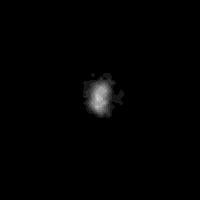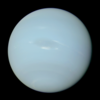Nereid (moon)
 Voyager 2 image (1989) | |
| Discovery | |
|---|---|
| Discovered by | Gerard P. Kuiper[1] |
| Discovery date | 1 May 1949 |
| Designations | |
| Pronunciation | /ˈnɪəri.ɪd/ or /ˈnɛri.ɪd/[a] |
| Adjectives | Nereidian, Nereidean |
| Orbital characteristics | |
| Epoch J2000 | |
| Periapsis | 1372000 km (0.00917 AU) |
| Apoapsis | 9655000 km (0.06454 AU) |
| 5513787 km (0.03685 AU) | |
| Eccentricity | 0.7507[2][3] |
| 360.1362 d | |
Average orbital speed | 934 m/s |
| Inclination |
|
| Satellite of | Neptune |
| Physical characteristics | |
| 170±25 km[4] | |
| 0.48 d (11 h, 31 min)[5] | |
| Albedo | 0.155[4] |
| Temperature | ≈ 50 K mean (estimate) |
Nereid is the third-largest moon of Neptune. It has a highly eccentric orbit. It was the second moon of Neptune to be discovered, by Gerard Kuiper in 1949.
Discovery and naming
Nereid was discovered on 1 May 1949 by Gerard P. Kuiper on photographic plates taken with the 82-inch telescope at the McDonald Observatory. He proposed the name in the report of his discovery. It is named after the Nereids, sea-nymphs of Greek mythology and attendants of the god Neptune.[1] It was the second and last moon of Neptune to be discovered before the arrival of Voyager 2 (not counting a single observation of an occultation by Larissa in 1981).[6]
Orbit and rotation
Nereid orbits Neptune in the prograde direction at an average distance of 5,513,400 km (3,425,900 mi), but its high eccentricity of 0.7507 takes it as close as 1,372,000 km (853,000 mi) and as far as 9,655,000 km (5,999,000 mi).[2][3]
The unusual orbit suggests that it may be either a captured asteroid or Kuiper belt object, or that it was an inner moon in the past and was perturbed during the capture of Neptune's largest moon Triton.[7]
In 1991, a rotation period of Nereid of about 13.6 hours was determined by an analysis of its light curve.[8] In 2003, another rotation period of about 11.52 ± 0.14 hours was measured.[5] However, this determination was later disputed. Other researchers have so far failed to detect any periodic modulation in Nereid's light curve.[9]
Physical characteristics
Nereid is Neptune's third-largest satellite and has an average radius of about 170 kilometres (110 mi).[4] It is rather large for an irregular satellite.[5] The shape of Nereid is not known.[9]
Since 1987 some photometric observations of Nereid have detected large (by ~1 of magnitude) variations of it brightness, which can happen over years and months, but sometimes even over a few days. They persist even after a correction for distance and phase effects. On the other hand, not all astronomers who have observed Nereid have noticed such variations. This means that they may be quite chaotic. To date there is no credible explanation of the variations, but, if they exist, they are likely related to the rotation of Nereid. Nereid's rotation can be either in the state of forced precession or even chaotic rotation (like Hyperion) due to its highly elliptical orbit. In any case its rotation should be rather irregular.[9]
Spectrally Nereid appears neutral in colour[10] and water ice has been detected on its surface.[7] Its spectrum appears to be intermediate between Uranus's moons Titania and Umbriel, which suggests that Nereid's surface is composed of a mixture of water ice and some spectrally neutral material.[7] The spectrum is markedly different from the outer-Solar-System minor planets, centaurs Pholus, Chiron and Chariklo, suggesting that Nereid formed around Neptune rather than being a captured body.[7]
Halimede, which has similar colours, may be a fragment of Nereid that was broken off during a collision.[10]
Exploration
The only spacecraft to visit Nereid is Voyager 2, which passed it at a distance of 4,700,000 km (2,900,000 mi)[11] between 20 April and 19 August 1989.[12] Voyager 2 obtained 83 images with observation accuracies of 70 km (43 mi) to 800 km (500 mi).[12] Prior to Voyager 2's arrival, observations of Nereid had been limited to ground-based observations that could only establish its intrinsic brightness and orbital elements.[13] Although the images obtained by Voyager 2 do not have a high enough resolution to allow surface features to be distinguished, Voyager 2 was able to measure the size of Nereid and found that it was grey in colour and had a higher albedo than Neptune's other small satellites.[6]
In fiction
In the Larry Niven book Ringworld, Nereid is described as having been leased by the outsiders "half a millennium ago". The protagonist, Louis Wu, speculates that the outsiders evolved on a gas giant moon similar to Nereid.
Notes
References
- ^ a b
Kuiper, G. P. (August 1949). "The Second Satellite of Neptune". Publications of the Astronomical Society of the Pacific. 61: 175–176. Bibcode:1949PASP...61..175K. doi:10.1086/126166.
{{cite journal}}: Invalid|ref=harv(help) - ^ a b c Jacobson, R. A. — AJ (2009-04-03). "Planetary Satellite Mean Orbital Parameters". JPL satellite ephemeris. JPL (Solar System Dynamics). Retrieved 2011-10-26. Archived October 5, 2011, at WebCite.
- ^ a b c
Jacobson, R. A. (3 April 2009). "The Orbits of the Neptunian Satellites and the Orientation of the Pole of Neptune". The Astronomical Journal. 137 (5): 4322–4329. Bibcode:2009AJ....137.4322J. doi:10.1088/0004-6256/137/5/4322.
{{cite journal}}: Invalid|ref=harv(help) - ^ a b c
"Planetary Satellite Physical Parameters". JPL (Solar System Dynamics). Archived from the original on 2010-01-18. Retrieved 2011-10-26.
{{cite web}}: Unknown parameter|deadurl=ignored (|url-status=suggested) (help) - ^ a b c Grav, T.; M. Holman; J. J. Kavelaars (2003). "The Short Rotation Period of Nereid". The Astrophysical Journal. 591 (1): 71–74. arXiv:astro-ph/0306001. Bibcode:2003ApJ...591L..71G. doi:10.1086/377067.
- ^ a b Smith, B. A.; Soderblom, L. A.; Banfield, D.; Barnet, C.; Basilevsky, A. T.; Beebe, R. F.; Bollinger, K.; Boyce, J. M.; Brahic, A. (1989). "Voyager 2 at Neptune: Imaging Science Results". Science. 246 (4936): 1422–1449. Bibcode:1989Sci...246.1422S. doi:10.1126/science.246.4936.1422. PMID 17755997.
- ^ a b c d Brown, Michael E.; Koresko, Christopher D.; Blake, Geoffrey A. (December 1998). "Detection of Water Ice on Nereid". The Astrophysical Journal. 508 (2): L175–L176. Bibcode:1998ApJ...508L.175B. doi:10.1086/311741.
- ^
Williams, I.P.; Jones, D.H.P.; Taylor, D.B. (1991). "The rotation period of Nereid". Monthly Notices of the Royal Astronomical Society. 250: 1P–2P. Bibcode:1991MNRAS.250P...1W. doi:10.1093/mnras/250.1.1p.
{{cite journal}}: CS1 maint: unflagged free DOI (link) - ^ a b c Shaefer, Bradley E.; Tourtellotte, Suzanne W.; Rabinowitz, David L.; Schaefer, Martha W. (2008). "Nereid: Light curve for 1999–2006 and a scenario for its variations". Icarus. 196 (1): 225–240. arXiv:0804.2835. Bibcode:2008Icar..196..225S. doi:10.1016/j.icarus.2008.02.025.
- ^ a b
Grav, Tommy; Holman, Matthew J.; Fraser, Wesley C. (2004-09-20). "Photometry of Irregular Satellites of Uranus and Neptune". The Astrophysical Journal. 613 (1): L77–L80. arXiv:astro-ph/0405605. Bibcode:2004ApJ...613L..77G. doi:10.1086/424997.
{{cite journal}}: Invalid|ref=harv(help) - ^ Jones, Brian (1991). Exploring the Planets. Italy: W.H. Smith. p. 59. ISBN 0-8317-6975-0.
- ^ a b Jacobson, R.A. (1991). "Triton and Nereid astrographic observations from Voyager 2". Astronomy and Astrophysics Supplement Series. 90 (3): 541–563. Bibcode:1991A&AS...90..541J.
- ^ "PIA00054: Nereid". NASA. 1996-01-29. Retrieved 2009-11-08.



